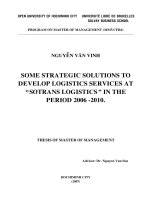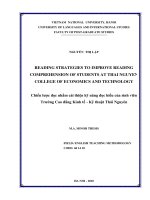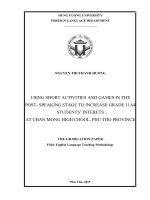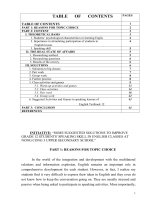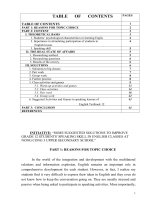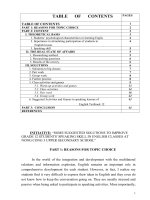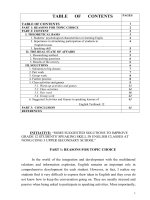DESIGNING STEM ORGANIC CHEMISTRY THEME TO DEVELOP GRADE 12 TH STUDENTS’ COMPETENCES IN APPLYING THEIR LEARNED KNOWLEDGE AND SKILLS
Bạn đang xem bản rút gọn của tài liệu. Xem và tải ngay bản đầy đủ của tài liệu tại đây (461.42 KB, 10 trang )
<span class="text_page_counter">Trang 1</span><div class="page_container" data-page="1">
<b>DESIGNING STEM ORGANIC CHEMISTRY THEME </b>
<b>IN APPLYING THEIR LEARNED KNOWLEDGE AND SKILLS</b>
<b>Ly Huy Hoang<small>1*</small> and Truong Thi Hong Phuc<small>2</small></b><i><small>1</small>Department of Postgraduate Studies, Dong Thap University</i>
<i><small>2</small>Lai Vung 2 High School, Dong Thap Province</i>
<i><small>*</small>Corresponding author: </i>
<i><b>Keywords: 5E model, applying knowledge and skills, STEM, STEM education.</b></i>
<small>DOI: Ly Huy Hoang and Truong Thi Hong Phuc. (2022). Designing STEM organic chemistry theme to develop grade 12th</small>
<i><small>students’ competences in applying their learned knowledge and skills. Dong Thap University Journal of Science, 11(3), 9-18.</small></i>
</div><span class="text_page_counter">Trang 2</span><div class="page_container" data-page="2"><b>THIẾT KẾ CHỦ ĐỀ GIÁO DỤC STEM DẠY HỌC PHẦN HÓA HỮU CƠ LỚP 12 THEO ĐỊNH HƯỚNG PHÁT TRIỂN NĂNG LỰC </b>
<b>VẬN DỤNG KIẾN THỨC, KĨ NĂNG ĐÃ HỌC CHO HỌC SINH</b>
<b>Lý Huy Hoàng<small>1*</small> và Trương Thị Hồng Phúc<small>2</small></b><i><small>1</small>Phòng Đào tạo Sau đại học, Trường Đại học Đồng Tháp</i>
<i><small>2</small>Trường Trung học phổ thông Lai Vung 2, tỉnh Đồng Tháp</i>
<i><small>*</small>Tác giả liên hệ: </i>
<i><b>Từ khóa: Giáo dục STEM, STEM, mơ hình 5E, vận dụng kiến thức kĩ năng.</b></i>
</div><span class="text_page_counter">Trang 3</span><div class="page_container" data-page="3"><b>1. Introduction</b>
Resolution No. 29/NQ-TW dated November 4, 2013 of the 8<small>th</small> Central Conference, term XI showed that the general education needs to focus on
<i>“developing creativity, self-learning, encourageing learning in life” and “innovating strongly, synchronously the basic elements of education, training in developing the qualities and competences of learners” (Central Executive Committee, 2013). </i>
Directive No. 16/CT-TTg of Prime Minister dated May 4, 2017 proposed the solutions in education:
<i>“Changing radically the policy, content, education method and vocational training to have human resources who can receive the new production technology, of which the promotion of training about Science, Technology, Engineering, Mathematics (STEM), Foreign languages must be concentrated in high school education” (Prime Minister, 2017, p.3). </i>
STEM term appears the fi rst time in America from the 90 years of the 20<small>th</small> century. This term usually
<i>appears with other terms, such as STEM fi eld, STEM </i>
<i>education, STEM human resource, and so on. STEM </i>
education has been understood as an interdisciplinary approach to the student learning process. America has another term “Integrated STEM education” to emphasize the importance of this approach (Nguyen
<i>Sy Nam et al., 2018, p.25). </i>
Today, the trend of STEM education is suitable for education innovation. However, it has not deeply researched in the contexts of Vietnam, especially in teaching Chemistry at high schools.
The general education program aims at developing specific competences for students, namely language competence, mathematic competence, science competence, technology competence, information competence, beauty competence, and physical competence (Ministry of Education and Training, 2018a). The chemistry subject in this program contributes to building chemical competences for students based on three parts of chemistry awareness; learning the natural world through chemistry topics; and applying the learned knowledge, skills (Ministry of Education
and Training, 2018b). Since the content of organic chemistry (in 12<small>th</small>-grade Chemistry) is related to real life, teachers should design STEM education activities appying the learned knowledge and skills to develop students’ competences. With this in mind, we present the summary of STEM education and our implementation in designing the theme “Plastic from Milk” based on 5E model in 12<small>th</small>-grade Chemistry subject to develop students’ competence in applying their learned knowledge and skills.
- Applying the chemical knowledge to discover and explain natural phenomena, the application of chemistry in life.
- Applying the chemical knowledge to review, assess the eff ectiveness of the practical problem.
- Applying the general knowledge to assess the eff ectiveness of the practical problem and propose some methods, measure, model, and plan to solve problems.
- Orienting for careers after graduation.
- Behaving appropriately in situations related to self, family and community in accordance with the requirements of sustainable social development and environmental protection.
We propose high school students’ competence of applying the learned knowledge skill through the teaching STEM education as follows:
</div><span class="text_page_counter">Trang 4</span><div class="page_container" data-page="4"><b>Table 1. Students’ competence of applying the learned knowledge and skill</b>
1 <sup>Recognizing the new practical </sup><sub>problems</sub>
1. Applying the chemical knowledge to discover the chemical application in life.
2. Raising practical problems though STEM theme.
2 <sup>Determining the knowledge </sup><sub>to solve practical problems </sub> <sup>3. Collecting information, knowledge related to STEM theme. </sup>
4. Using the related knowledge to solve the proposed problem in STEM theme. 3
Proposing plans, using technologies and materials to perform the proposed plans.
5. Proposing research questions and plans for STEM theme.
6. Proposing the suitable solutions to solve the plans in STEM theme. 7. Using techniques and materials to perform the solutions.
4 <sup>Explaining, refuting the </sup><sub>practical problems </sub> <sup>8. Applying the knowledge to explain the practical problems of STEM theme. </sup>9. Presenting, refuting production of STEM theme clearly, logic.
5 <sup>Proposing and applying the new </sup><sub>ideas into practice</sub> 10. Proposing the new ideas and applying into practice based on STEM theme.
<b>2.2. Overview of STEM education</b>
STEM is abbreviation term of words as Science, Technology, Engineering and Mathematics (Ministry of Education and Training, 2019). STEM was used to discuss the develop policy about STEM Science, Technology, Engineering and Mathematics of America.
STEM education was defined: “STEM education is the activities of education which have the interdisciplinary property when adverting two or more of them. The learning content is associated with practice and teaching methods are oriented to activities” (Luong Xuan Quang, 2017). Nowadays, organizations and educators are interested in STEM education. The defi nition of STEM education is based on the diff erent ways of understanding. It includes mainly Science, Technology, Engineering and Mathematics subjects; Integration (interdisciplinary) of the 4 fi elds of Science, Technology, Engineering and Mathematics; or Integration (interdisciplinary) of 2 or more fi elds of Science, Technology, Engineering and Mathematics.
The current program does not have any STEM components. It is only the single subject taught in STEM orientation or combined subjects of oriented-STEM to build the STEM theme. The most important purpose of building STEM theme is oriented to real life, helping students solve practical problems and
<b>2.3. The 5E model in design the theme of STEM education</b>
The 5E model was initiated by Rodger W. Bybee (2006) based on the idea of Johann Friedrich Herbart. He is a philosopher who greatly infl uenced American education in the 20<small>th</small> century. Later, John Dewey, a science teacher, contributed signifi cantly to the building of the 5E model and pointed out that learners' knowledge acquisition is refl ected through their own thinking. Then, he invented the model "Developing science and health to a new level" of BSCS - Biological Sciences Curriculum Study in the 1980s. The 5E model is built and completed as it is today (Rodger, 2015). The 5E process plays an important role in curriculum development and curriculum development for science classes. Today, some authors are interested in the 5E process and consider it as a suitable process for educating STEM.
ÅÅ
</div><span class="text_page_counter">Trang 5</span><div class="page_container" data-page="5">13The 5E is abbreviated from 5 words as Engage,
Explore, Explain, Elaborate and Evaluate. These are equilibrium with 5 steps of the teaching process (Rodger, 2015). The 5 steps are presented as seen in Figure 1.
<b>Step 1. Engage</b>
In the first step, the teacher helps students increase interest and excitement about lesson content or activity. Many diff erent arousing ways depend on the lesson content or activity. In this step, the teacher will obtain assessments, review to identify the excitement and interest about the learning content. The teacher uses the above information to modify the 5E model.
<b>Step 2. Explore</b>
In this step, students begin to do their experiments. They build the knowledge of the theme for themselves by searching and exploring data. The teacher only plays the role of coordinator, supervisor, and materials provider. Students make their assumptions. After the self-test, they give conclusions. Teachers should help students in exploring and using critical thinking by questions, observing, and analyzing data. To promote and encourage group work when students do their experiments, teachers can divide groups and assign specifi c tasks to each member in every group.
<b>Step 3. Explain</b>
The teacher and students are together to explain the phenomena, to fi nd the answer for their guesses. Students discuss with other students or teachers about the learned works. After that, teachers explain and standardize the terms, defi nitions, concepts and explain the process.
<b>Step 4. Elaborate</b>
Elaborate, also called as Extend, expands the topic or connects with other similar themes in the natural sciences. The student can have more knowledge to apply to life. This step provides an opportunity for students to apply in new situations and develop a deeper understanding.
<b>Step 5. Evaluate</b>
In the last step, the students assess all contents that they learned. They compare their obtained knowledge with the knowledge they have. The assessment tools are very diverse, including the notes or illustration fi gures during the above steps. These
tools can be the presentations or products and not necessarily assessed through test formats.
<b>2.4. Designing the theme of STEM education “Plastic from Milk” to teach organic chemistry in 12<small>th</small>-grade Chemistry</b>
By analyzing the content in the organic chemistry of 12<small>th</small> grade Chemistry, the teacher can design STEM themes as products of the natural soap, the fruit juice, the paper from bagasse, Plastic from Milk, etc. This paper introduces the teaching plan of the STEM theme “Plastic from Milk”. This theme is designed in the orientation of the 5E model.
<i>2.4.1. The reasons for choosing this subject </i>
Plastic material is familiar to students. Diff erent kinds of plastic can be used to create application products in society, but how to make a product from plastic? This choice is suitable to help students in practical experiences. The students can apply the learned knowledge from the lesson “peptide and protein” to create some products from milk.
<i>2.4.2. The STEM knowledge in the theme </i>
- Science (S): The coagulation of proteins in milk- Technology (T): Using the ingredients that are easy to fi nd and safe: milk, vinegar, lemon juice.
- Engineering (E): Procedure plot of creating Plastic from Milk.
- Mathematics (M): The mathematics is applied to calculate the ratio of milk and vinegar to have durable plastic and waterproof; Calculating the mass of product from milk and vinegar.
<i>2.4.3. Time to do this theme: 2 periods </i>
<b>and competence</b>
<b>ObjectivesThe chemical competence</b>
Be aware of chemistry
- Determine the chemical tions of milk.
composi-- Give the physical properties of the protein.
- Explain curdling protein between milk and white vinegar.
</div><span class="text_page_counter">Trang 6</span><div class="page_container" data-page="6">Learn from nature via chemical observations
- Design the procedure of sized plastic from milk and white vinegar.
synthe-- Experiment to prepare plastic from milk and white vinegar.Apply the learned
knowledge and skills
- Apply the curdling protein to explain the forming of plastic from milk and white vinegar.
- Connect the procedure to life.
<b>The general competence</b>
Solve the problem creatively
- Plan and conduct experiments between milk and vinegar. Communicate and
- Discuss with other group members about the procedure and product.
<b>The main quality</b>
Be honest <sup>- Honestly report the experiment </sup><sub>and results. </sub>Be responsible
- Ensure safety for others, preserve and use the chemicals and materials reasonably.
<b>b. Materials and tools </b>
- Ingredients: fat-free milk, white vinegar, baking soda, food coloring, water.
- Tools: measuring tube, tempered glass cup, plastic cup, fi lter paper, wooden stick, plastic spoon, template to create a shape.
<b>c. Learning activities</b>
<i>Activity 1: Engage</i>
The teacher prepares some plastic items like bags, bottles and cell phone cases for students to observe. The teacher gives the questions:
(1) Do you think all the plastic items with general features?
(2) Can you give the reason why these things
are made from plastic materials? Please give some specifi c properties.
(3) What material can be used to produce these plastic items?
The teacher tells the students that they will now perform the polymerization reactions themselves to create a polymer. Instead of using oil as the starting material, we will use milk. What do you think will happen to the milk during the experiment? Why does it turn into plastic? Which components of milk can act as monomers of milk polymers?
Students are required to give:
- The answers to question 1 to question 3.- The answers to the provocative question. It can be right or wrong.
<i>Activity 2: Explore</i>
In this step, students begin the experiment, exploring to build the knowledge of the topic for themselves.
The teacher divides student into groups and guides them to experiment with producing plastic from milk. The teacher guides them to experiment with the following:
(1) Use duct tape, paper, pen, and labels for 4 cups: 1, 2, 4 and 8.
(2) Use a teaspoon to add white vinegar: cups containing 1, 2, 4, and 8 teaspoons of white vinegar are labeled "1", "2", "4", and "8", respectively.
(3) Heat 4 cups of milk (~ 1 liter) in a microwave at ~ 49<small>o</small>C.
(4) Add four cups of hot milk to four cups of white vinegar, respectively. Note your observations in the data table.
<b>Table 2. Experiment data of “plastic from milk” theme </b>
<b>Quantity of vinegar teaspoons</b>
<b>Forms curds? (yes/no)</b>
<b>Describe liquid after sieve</b>
<b>Weight of casein plastic (in grams)</b>
<b>Write down any other observations</b>
1 248
(5) Stir the cups of hot milk - vinegar in a few seconds to do the chemical reaction.
this step with the other cups. Four cups were labelled as "1", "2", "4", and "8" by prepared tape.
</div><span class="text_page_counter">Trang 7</span><div class="page_container" data-page="7">15“1” into the cotton sieve over cup “1”. When the milk
and vinegar mixture go into the sieve, the curds milk will gather on the top of the sieve and the liquid will drain into the below cup.
(8) Write the information into the data table in line 1 for cup “1”.
(9) Carefully remove the wire sieve on cup “1”; Squeeze all excess liquid out of the curd milk with your hands; Scrape the curd milk off the cotton cloth and knead them into a ball to collect the plastic.
(10) Determine the weight of the collected plastic on the electronic scale. After one piece of paper on the scale disk, put the plastic ball on the scale surface; Record the weight in the information sheet.
(11) Repeat the steps 7 to 10 for diff erent cups.(12) Students can create diff erent shapes and colours from the prepared plastic by adding food colouring and pressing into the template in diff erent templates.
Expected students’ outcomes:
- The product of plastic of the groups
- The experiment data of synthesized plastic from milk. Give the conclusion of the suitable ratio of milk and vinegar.
<i>Activity 3: Explain</i>
After completing the tasks, students answer the questions of the teacher.
Suggested questions for teacher:
Question 1. What happens when vinegar is poured into milk? Explain what happened?
Question 2. What colour is the remaining liquid in the transparent cup?
Question 3. What is the shape of the curd?Question 4. How do you feel when kneading curd? Does its consistency change over time when kneading?
Question 5. Describe some characteristics of the prepared plastic product? (How clear is it? How does it feel? Is it fragile? Is it water-resistant?)
Question 6. Most of the plastics are made from oil but not milk. What impact do you think on the environment and society?
Expected students’ outcomes: Students' responses.
<i>Activity 4: Extend</i>
To deepen and expand the knowledge for students, the teacher asks students to apply the plastic processing process to conduct experiments with diff erent components.
</div><span class="text_page_counter">Trang 8</span><div class="page_container" data-page="8"><i>Activity 5: Evaluate</i>
The teacher assigns a representative student of each group to report the group's work and the group representative to present the questions. Other groups participate in discussing the results of the reporting group.
After students report on the product and answer questions, the teacher evaluates them on several criteria:
- Products made with durability, water permeability, shapes of created products.
- Ability to communicate in class.Students’ expected products:
- The plastic product of the group has been prepared.
- The presentation of groups.
<b>2.5. Results of the experiment</b>
The experiment was performed in only one group to evaluate the eff ects.
Before the experiment: The teacher gives the test to students to evaluate the competence of apply the learned knowledge and skill in the observation sheet
of communicative competence (Table 1).
After the experiment: Teacher conducts the test to students, combine the average mark of student in performing the STEM theme, re-evaluate the competence of applying knowledge and skill in observation sheet of communicative competence (Table 1).
We performed a pedagogical experiment with the theme “Plastics from Milk” in the orientation of STEM education for 12th graders (84 students) of Lai Vung 2 High School, Dong Thap Province in the 2020-2021 school year; we designed the teaching plan and performed the activities in the form of extra-curricular activities. The participating groups have good quality products. The results were calculated by the average score from the assessment of the teacher.
The obtained data were analysed by SPSS 22.0 software. In each assessment criterion of the competence of applying knowledge and skills of students (from 1 to 10), we reported the values of the frequency of each level, the standard deviation, the diff erence of mean and the t-Test as shown in Table 3.
<b>Table 3. The competence of applying the learned knowledge and skills in practice of students before and after the experiment</b>
<i><b>Assessment Criteria<small>*</small></b></i>
<i><b>Frequency of Students Getting Grades</b></i><b><small>**</small></b>
<i><b>Standard </b></i>
<i><b>Deviation<sup>Diff erence of </sup>Means</b></i>
<i><b>t-Test (Sig.)</b></i>
</div><span class="text_page_counter">Trang 9</span><div class="page_container" data-page="9">17Level 1 (1 point): Low level of competence
- Students express themselves infrequently and inactively.
L e v e l 2 ( 2 p o i n t s ) : A v e r a g e l e v e l o f competence - Students express themselves quite
frequently and actively.
Level 3 (3 points): High level of competence - Students express themselves frequently and actively.
Similarly, the average values of 10 criterions before and after the experiment shown in Table 4.
<b>Table 4. Comparison of the average values of 10 criterions before and after the experiment</b>
<i><b>GroupMean Std. Deviation<sup>Diff erence of </sup><sub>Means</sub>P (Sig.)ES</b></i>
<b>Figure 3. The average scores before and after the intervention </b>
The results in Table 4 and Figure 3 showed that the average score of the criterion on the competence of applying the learned knowledge and skills by the students after the intervention increased signifi cantly (the diff erence of average value is 0.62). It indicated that STEM education-oriented teaching has a positive impact on developing students’ competence of applying the learned knowledge and skills. The t-Test results of all the criteria are less than 0.05, which proves that the mean score of the criteria of the experimental class is signifi cant with 95% confi dence. The value of 1.32 in infl uence level (ES) is big. The value of t-Test and ES indicated that the intervention
is positive and this study can be replicated.
<b>3. Conclusion</b>
STEM education is necessary educational orientation in the current educational context of Vietnam. It promotes the development of Science, Technology, Engineering and Mathematics. The theme "Plastic from Milk" is designed according to the 5E model to help students apply learned knowledge to solve practical problems. Through the implementation of this STEM theme, students are more active, creative, and interested in learning Chemistry, and at the same time, they form and develop the competence
</div><span class="text_page_counter">Trang 10</span><div class="page_container" data-page="10">of applying learned knowledge and skills. Besides, the students can develop their competencies of the 21st century, including those of solving problems, creativity, and cooperation. They conform to innovating the general education program today.
<b>Acknowledgement: This research is supported </b>
by science and technology project, Dong Thap University. Code: SPD2020.01.04.
<i>Central Steering Committee (2013), Resolution </i>
<i>No. 29/NQ-TW dated November 4, 2013 on “fundamental and comprehensive innovation in education, serving industrialization and modernization in a socialist-oriented market economy during international integration” ratifi ed in the 8th session.</i>
Le Lan Huong and Dang Thi Oanh (2018). Developing students' competence to apply knowledge into practice using chemistry exercises about aldehydes - ketones - carboxylic acids in
<i>grade 11. Journal of Science Hanoi National </i>
<i>University of Education, No. 63, 162-177. </i>
<i>Luong Xuan Quang (2017). Teaching the technology </i>
<i>in high school in orientation of STEM education. </i>
Hanoi National University of Education, Vietnam.
<i>Ministry of Education and Training (2018a). General </i>
<i>education program - overall program (Issued together with Circular No.32/2018/TT-BGDĐT December 26, 2018 of the Minister of Education and Training).</i>
Ministry of Education and Training (2018b).
<i>General education program - Chemistry (Issued together with Circular No.32/2018/TT-BGDĐT December 26, 2018 of the Minister of Education and Training).</i>
<i>Ministry of Education and Training (2019). Training </i>
<i>materials for administrators and teachers on building STEM education topics in secondary education.</i>
Nguyen Sy Nam, Dao Ngoc Chinh and Phan Thi Bich Loi (2018). Some issues about STEM education in high schools to response the new general
<i>education program. Journal of Education, </i>
<i>Special issue September 2018, 25-29.</i>
<i>Prime Minister (2017). Directive No. 16/CT-TTg on </i>
<i>the strengthening of the ability to access the fourth industrial revolution.</i>
<i>Rodger, W. B. (2015). The BSCS 5E Instructional </i>
<i>Model: Creating teachable moments. NSTA press.</i>
</div>
